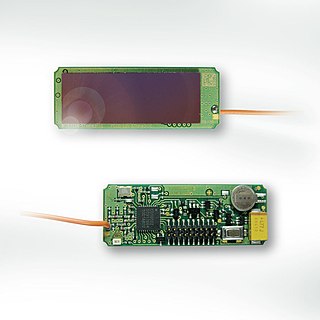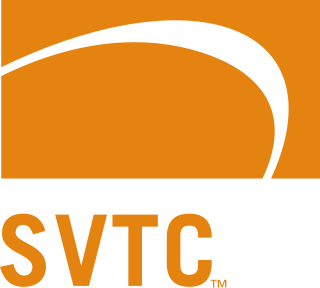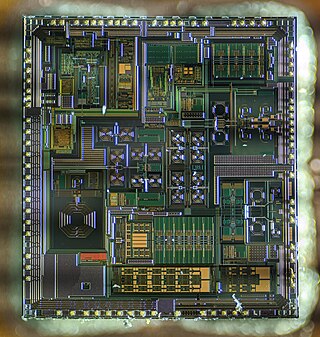
MEMS is the technology of microscopic devices incorporating both electronic and moving parts. MEMS are made up of components between 1 and 100 micrometres in size, and MEMS devices generally range in size from 20 micrometres to a millimetre, although components arranged in arrays can be more than 1000 mm2. They usually consist of a central unit that processes data and several components that interact with the surroundings.
Atmel Corporation was a creator and manufacturer of semiconductors before being subsumed by Microchip Technology in 2016. Atmel was founded in 1984. The company focused on embedded systems built around microcontrollers. Its products included microcontrollers radio-frequency (RF) devices including Wi-Fi, EEPROM, and flash memory devices, symmetric and asymmetric security chips, touch sensors and controllers, and application-specific products. Atmel supplies its devices as standard products, application-specific integrated circuits (ASICs), or application-specific standard product (ASSPs) depending on the requirements of its customers.

Freescale Semiconductor, Inc. was an American semiconductor manufacturer. It was created by the divestiture of the Semiconductor Products Sector of Motorola in 2004. Freescale focused their integrated circuit products on the automotive, embedded and communications markets. It was bought by a private investor group in 2006, and subsequently merged with NXP Semiconductors in 2015.

Infineon Technologies AG is Germany's largest semiconductor manufacturer. The company was spun-off from Siemens AG in 1999. Infineon has about 58,600 employees in 2023 and is one of the ten largest semiconductor manufacturers worldwide. In 2023 the company achieved sales of €16.309 billion.

Analog Devices, Inc. (ADI), also known simply as Analog, is an American multinational semiconductor company specializing in data conversion, signal processing, and power management technology, headquartered in Wilmington, Massachusetts.

Nordic Semiconductor ASA was founded in 1983 and is a Norwegian fabless technology company with its headquarters in Trondheim, Norway. The company specializes in designing ultra-low-power wireless communication semiconductors and supporting software for engineers developing and manufacturing Internet of Things (IoT) products.

The EnOcean technology is an energy harvesting wireless technology used primarily in building automation systems, but also in other application fields such as industry, transportation, and logistics. The energy harvesting wireless modules are manufactured and marketed by the company EnOcean, headquartered in Oberhaching near Munich. The modules combine micro energy converters with ultra low power electronics and wireless communications and enable batteryless, wireless sensors, switches, and controls.
Maxim Integrated Products, Inc., was an American semiconductor company that designed, manufactured, and sold analog and mixed-signal integrated circuits for the automotive, industrial, communications, consumer, and computing markets. Maxim's product portfolio included power and battery management ICs, sensors, analog ICs, interface ICs, communications solutions, digital ICs, embedded security, and microcontrollers. The company is headquartered in San Jose, California, and has design centers, manufacturing facilities, and sales offices worldwide. In 2021, the company was acquired by Analog Devices.
Microchip Technology Incorporated is a publicly listed American corporation that manufactures microcontroller, mixed-signal, analog, and Flash-IP integrated circuits. Its products include microcontrollers, Serial EEPROM devices, Serial SRAM devices, embedded security devices, radio frequency (RF) devices, thermal, power, and battery management analog devices, as well as linear, interface and wireless products.

The X-FAB Silicon Foundries is a group of semiconductor foundries. The group specializes in the fabrication of analog and mixed-signal integrated circuits for fabless semiconductor companies, as well as MEMS and solutions for high voltage applications. The holding company named "X-FAB Silicon Foundries SE" is based in Tessenderlo, Belgium while its headquarters is located in Erfurt, Germany.
Elmos Semiconductor SE is a German manufacturer of semiconductor products headquartered in Dortmund, Germany. Elmos supplies automotive application-specific integrated circuits (ASICs).
Crocus Technology, founded in 2004, was a venture-capital-backed semiconductor startup company developing and manufacturing integrated magnetic field sensors for a variety of applications: Automotive, consumer goods, industrial and medical IoT.
DASH7 Alliance Protocol (D7A) is an open-source wireless sensor and actuator network protocol, which operates in the 433 MHz, 868 MHz and 915 MHz unlicensed ISM/SRD band. DASH7 provides multi-year battery life, range of up to 2 km, low latency for connecting with moving things, a very small open-source protocol stack, AES 128-bit shared-key encryption support, and data transfer of up to 167 kbit/s. The DASH7 Alliance Protocol is the name of the technology promoted by the non-profit consortium called the DASH7 Alliance.
Kionix, Inc. is a manufacturer of MEMS inertial sensors. Headquartered in Ithaca, New York, United States, the company is a wholly owned subsidiary of ROHM Co., Ltd. of Japan. Kionix developed high-aspect-ratio silicon micromachining based on research originally conducted at Cornell University. The company offers inertial sensors, and development tools and application support to enable motion-based gaming; user-interface functionality in mobile handsets, personal navigation and TV remote controllers; and hard-disk-drive drop protection in mobile products. The company's MEMS products are also used in the automotive, industrial and health-care sectors. Kionix is ISO 9001:2008 and TS16949 registered.

SVTC Technologies was a technology services company that provided development and commercialization services for semiconductor process-based technologies and products. SVTC operated from 2004 to October 2012.

Tower Semiconductor Ltd. is an Israeli company that manufactures integrated circuits using specialty process technologies, including SiGe, BiCMOS, Silicon Photonics, SOI, mixed-signal and RFCMOS, CMOS image sensors, non-imaging sensors, power management (BCD), and non-volatile memory (NVM) as well as MEMS capabilities. Tower Semiconductor also owns 51% of TPSCo, an enterprise with Nuvoton Technology Corporation Japan (NTCJ).

EM Microelectronic, based in Marin, La Tène near Neuchâtel in Switzerland, is a developer and semiconductor manufacturer specialized in the design and production of ultra low power, low voltage integrated circuits for battery-operated and field-powered applications in consumer, automotive and industrial areas. It is a subsidiary of The Swatch Group.
Bruno Murari is an Italian inventor. During his career he has patented about 200 inventions in the field of circuit design, power technologies and MEMS devices. He is the only Italian to have received the Elmer A. Sperry Award, which is awarded to those who have distinguished themselves with proven engineering contributions to advance the field of transport. He was defined "legendary analog engineer" and "father" of the BCD technology.

RF CMOS is a metal–oxide–semiconductor (MOS) integrated circuit (IC) technology that integrates radio-frequency (RF), analog and digital electronics on a mixed-signal CMOS RF circuit chip. It is widely used in modern wireless telecommunications, such as cellular networks, Bluetooth, Wi-Fi, GPS receivers, broadcasting, vehicular communication systems, and the radio transceivers in all modern mobile phones and wireless networking devices. RF CMOS technology was pioneered by Pakistani engineer Asad Ali Abidi at UCLA during the late 1980s to early 1990s, and helped bring about the wireless revolution with the introduction of digital signal processing in wireless communications. The development and design of RF CMOS devices was enabled by van der Ziel's FET RF noise model, which was published in the early 1960s and remained largely forgotten until the 1990s.








